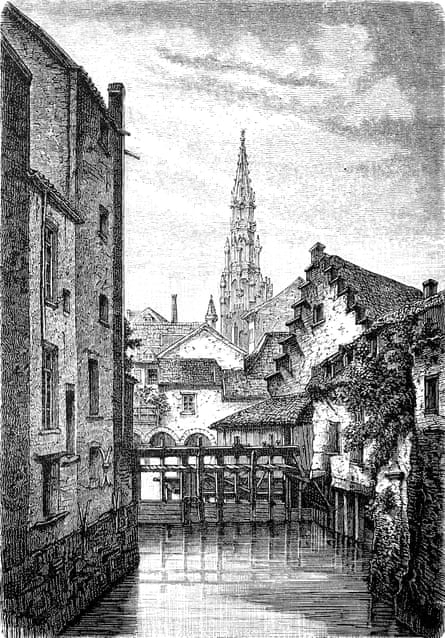While Paris’s winding Seine has been an inspiration for some of the greatest works of romantic art and literature, the unloved Senne running through Brussels has been buried away under concrete for the last 150 years, condemned by locals as little more than a sewer and cause of disease and unhappiness.
As a constant flood risk and source of cholera, it was vaulted in, built over and hidden from sight. Now, however, Belgium’s capital is preparing to stage an inauguration ceremony that officials hope will help force a rethink among Bruxellois about their centuries-held prejudices against the waterway.
After the removal of 1,966 tonnes of concrete, a 200-metre stretch of the Senne near the Buda suburb in north Brussels will be formally opened to the elements, with new banks constructed in part from the rubble of its former tomb.
It is to be the first step in the unpeeling of concrete that encases two-thirds of the Senne through the Brussels region. Officials concede it is being undertaken in the face of age-old beliefs that remain surprisingly strong in the city’s collective consciousness.
“The inherited memory in Brussels is that the river does not have a good reputation,” said Martin Ohse, of Bruxelles Environnement, the regional government agency responsible for the city’s surface waters. “People remember the sewer connotation which was around for 400 years, but now we need to switch that mentality. Even people who had never seen the river, it is almost intuitive that they were saying it is not a nice river. So we need to change that.”

Until well into the 19th century, human excrement in Brussels was collected by a street cleaning team known as the ferme des boues, who would pour the waste into pools where over time it would turn into urban manure to be sold to farmers.
But huge population growth in Brussels and elsewhere in Belgium led to a collapse in the human waste market. With Brussels boasting a canal network for the transport of goods, the Senne was seen as an obvious outlet for the growing sewage problem.
“The city of Brussels simply [had made] use of a natural law by dumping its sewage in the Senne,” the city’s administrators noted at the time of the river’s encasement, according to the academic Ananda Kohlbrenner in her seminal work, From Fertiliser to Waste, Land to River: a History of Excrement in Brussels.
Such was the horror at the subsequent cholera outbreaks and the desire of the ruling elite to raze the slums on the Senne’s banks and build sweeping Parisian-style boulevards over its waters that the river’s subsequent entombment was seen as a sign of progress to many in the higher echelons of society.
The covering of the Senne was so welcome that the first stone on the central Lemonnier-Anspach section was laid on 6 May 1867 by the king of the Belgians, Leopold II, who in turn had an eye on rebuilding the capital of his relatively new country to match those of the great European powers.
“It was above all the triumph of the bourgeoisie of the 19th century,” said Roel Jacobs, a local historian. “The desire was to raze the popular neighbourhoods to create a new environment for the urban elites.”
The works over the river were carried out between 1867 and 1871, but the ill-regard of Bruxellois to their waterway was to continue. A section north of the city was vaulted as recently as 1996, this time to mitigate against a potential spillage from petrol being stored locally.
But it was not until 2000 that any attempt was made to purify the wastewater flowing into the Senne’s fetid waters. A study in 2010 found not a single fish in the river, which was described by local administrators at the time as being “dead”.
By 2016, the first attempts to clean the wastewater started to bear fruit, with large shoals of fish identified. In 2019, work was undertaken to improve the conditions and accessibility of a stretch already open by Boulevard Paepsem in Anderlecht, a commune in south-west Brussels.

Funding from the EU was then obtained and permits sought to remove the concrete in the north near Buda, a task that is nearing completion, and plans are afoot to start work in 2023 for a 600-metre stretch of the Senne to be uncovered in Maximilien Park in the city centre.
“We will reorganise the park to have the river running through it. It is the only section in the centre that is covered under a green area,” Ohse said. “Other sections are under boulevards or the Midi [rail] station, so we cannot destroy the station to have the river. It is in the centre, so the number of people who will be able to see the river and enjoy it will be much higher.”
The works in the park are due to be completed by 2025. Other potential projects include offering people a landscape view of the river at the level of Brussels’ underground sewage museum near Midi station, and reopening it within a 40-hectare (100 acre) economic zone in north Brussels known as Schaerbeek-Formation.
Ohse said the quality of the water could not be guaranteed sufficiently for people to swim in the Senne today. “But perhaps one day,” he added. “By reducing the amount of waste into the river, you will purify your water, increase the oxygen in the water, the fish and plants are coming back, and if you want to include a river in the city it needs to be clean. People will otherwise see it as a sewer. We can see that nature is taking back control of the river.”
